Site Menu:
| This is an archived Horseadvice.com Discussion. The parent article and menus are available on the navigation menu below: |
| HorseAdvice.com » Diseases of Horses » Endocrine System » Pituitary Pars Intermedia Dysfunction (PPID): Equine Cushing's » |
| Discussion on Cushingoid/IR pony hoof pain | |
| Author | Message |
| Member: bluedog1 |
Posted on Thursday, Jul 12, 2007 - 9:07 pm: Hi Dr. O,Our 23 year old pony was diagnosed with cushings disease and Insulin resistance a few years ago. She has always been sound in the 5 years I have owned her. She has been barefoot for three years, trimmed by a natural hoof groom, and everyone, including farriers and vets,comments on what great hooves she has. She is currently used for lessons three times a week and hacked by myself or my daughter one or two more days. She jumps 2 feet in 2 lessons per week. The other rides are on the flat in good footing. We are VERY careful with her diet and clip her often to keep her comfortable. She has been on two teaspoons of ground Chaste Tree Berry (Vitex agnus castus) chromium yeast and vit E. Her ACTH, glucose and insulin are checked twice a year, and have been normal for the past year and a half. She is such a willing and sweet mount for the kids and has been packing them around for a number of years. A few months ago, late spring, she started looking really bad. She was lethargic, her coat was wirey, when normally it is very soft. Her topline was sagging and she got this big belly. She also had a long period with diarrhea. The vet had me start her on daily dewormer. Previoius to this, she was looking good for so long, that I stupidly cut back on the daily ration of ground Chaste Tree Berry (Vitex). When she started looking bad, I immediately put her back on her previous ration of Vitex. Her attitude, coat and body condition are much better. For the past two trims, my farrier has noted that her feet look different and that she was wearing them differently. I have noticed this too. She had the perfect barefoot hoof. Thick walls, concave sole, wide frogs etc. Her hooves still look good, but I would say those soles look a little flatter than they used to. Anyway, the reason for the post is that a few weeks ago I noticed she was walking toe first in the front. She started tripping quite often and then started ducking out of or stopping in front of the jumps during her lessons. This was so out of character for her, that I called the vet. The finding was that she is sore in all four hooves with lumbar pain. My Vet took an xray of the front right and found her sole was thin. I guess my question is how did her soles get thin? Could the episode in late spring caused a reaction somehow in the soles? Maybe her soles have always been this thickness and for some reason it has become problematic. The vet wants to have me put DuraSole on her soles for a week, and give her 1 gram bute once daily for three weeks. He wants to see her again at that point. He did not mention that she should be rested, but her lesson kids are all away for the next week so she will not be doing any jumping for a little while. I'm wondering how she has been barefoot with absolutely no problems with her hooves for three years and now there is a problem with the thickness of the sole. Could the episode from late spring have something to do with this? Or perhaps the daily dewormer? Those are the only two things I can think of that may have had an effect on her. Any comments you may have about what might be going on here would be very much appreciated. Thank you. |
| Member: bluedog1 |
Posted on Thursday, Jul 12, 2007 - 9:09 pm: I forgot to mention that the Vet was very happy to see that her coffin bone looked very good, no rotation, and the navicular bone also looked very good.
|
| Moderator: DrO |
Posted on Friday, Jul 13, 2007 - 6:55 am: Hello Jackie,I don't believe the spring incident was related to the dosage of the chaste berry but instead related to whatever was causing the diarrhea which is not a usual symptom of Cushings though often a problem of older horses. Was there a reason to suspect parasitism or heavy exposure to pasture larva? As to the thinness of the soles, I really cannot diagnose the cause since I cannot examine the radiographs nor have I seen the pony's feet. It certainly is possible that the feet have been this way and now something has happened that has made them sensitive. I would also like to note that measuring solar thickness is a tricky deal requiring precise angling, well marked solar margins, well marked ground surface, angle, and a appreciation of the magnification effect of radiographs. So I am almost afraid to ask: how thick is the sole at the toe? The best way to get this question answered is to get your veterinary and farrier together and discuss the findings and see if they can reach some conclusions. We would love to know how this turns out. Considering the history certainly founder is on the list of most likely causes so for more on proper treatment see the article on Cushings and follow the links to the founder article. DrO |
| Member: bluedog1 |
Posted on Friday, Jul 13, 2007 - 9:00 am: Thanks Dr. O.I'm not sure why the vet suggested the dewormer. Other than her appearance and the prolonged diarrhea, there was nothing to indicate heavy exposure. I didn't mention that prior to suggesting the strongid-C, we doubled her probios and started her on a gut conditioner call SUCCEED. The diarrhea continued and that's when we went to the dewormer. She is no longer on Succeed. As for the radiographs..they were taken with a digital xray and the images were amazingly clear. The thin soles were diagnosed without measuring so I was not given any thickness measurement. The coffin bone showed no rotation and navicular also looked good. Should I be concerned with founder if this is the case? If a horse is sore footed from thin soles, how can we encourage sole growth? I was always under the impression that building sole comes from movement where the sole is active. But if the horse is in pain, how do we go about encouraging the sole to thicken? Should I try a hoof supplement? What do you think about using hoof boots for exercise? Thanks again for your comments. I will keep you posted on Dakotah's progress. I will also try and post some pictures of her feet. Jackie |
| Moderator: DrO |
Posted on Sunday, Jul 15, 2007 - 8:55 am: For ideas on improving horn quality see Diseases of Horses » Lameness » Diseases of the Hoof » Poor Horn Quality: problems with the wall and soles. For ideas on how to deal with thin sensitive soles see Diseases of Horses » Lameness » Diseases of the Hoof » Problems Following Shoeing or Trimming.I do not see any reason to cross founder off the list of possibilities. DrO |
| Member: bluedog1 |
Posted on Monday, Jul 16, 2007 - 4:37 pm: Dr. O,Here is a link to some pictures I took today. I decided, that even though my vet said I should give her bute and that she still can be ridden, that I am going to let her have a rest for several weeks. She gets turned out in her dirt paddock and will be given her bute daily, but no forced exercise. It just didn't seem right to me to make a horse with sore feet to move. Here is the link to the pictures. https://s92.photobucket.com/albums/l4/bluedog1234/ Jackie |
| Moderator: DrO |
Posted on Tuesday, Jul 17, 2007 - 7:14 am: Jackie,if you will place the images in the discussion so they become a permanent part of this record I would be glad to review them. For information on uploading images see Help & Information » Uploading Images and Files Into a Posting. DrO |
| Member: bluedog1 |
Posted on Wednesday, Jul 18, 2007 - 2:08 pm: Ok, here they are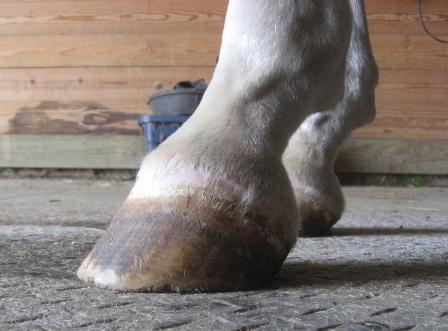 Left front Left front 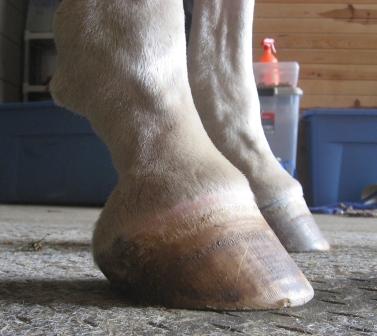 Right Front Right Front 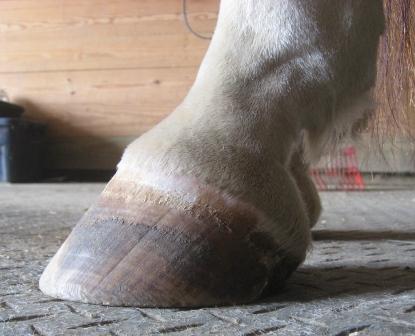 Left Hind Left Hind 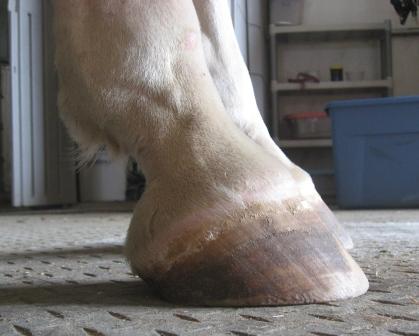 Right Hind Right Hind 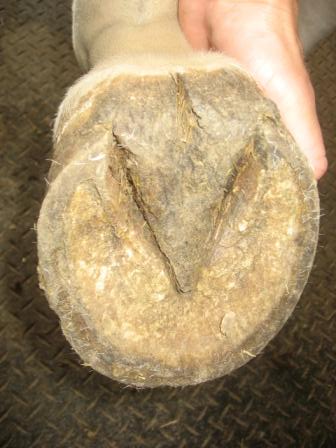 Left front Left front 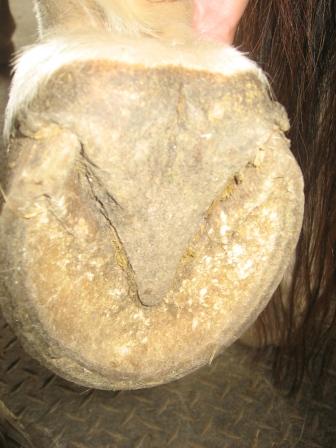 Left Hind Left Hind 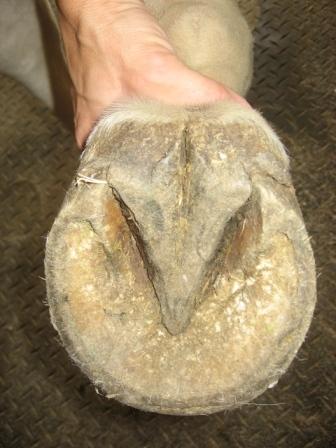 Right front Right front 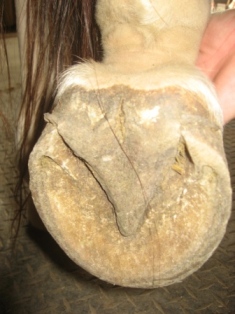 Right Hind Right Hind 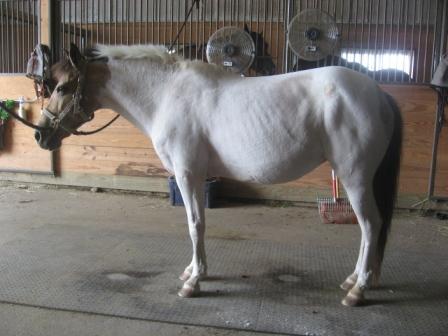 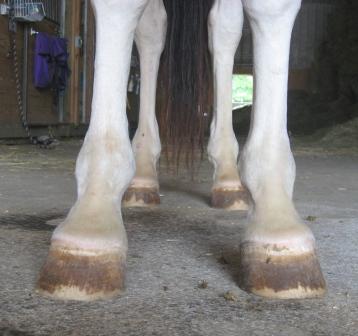 I was out to see Dakotah yesterday and she walked fine, but didn't want her left front hoof held up for picking. Another behavior that is not normal for her. She usually holds up her feet with no problems. |
| Member: bucky |
Posted on Wednesday, Jul 18, 2007 - 3:39 pm: Jackie,Such a cute little horse I hope you get it figured out. My favorite old mare also came down with cushings. Her feet really changed also but she never foundered. I had to keep a close eye on her and am surprised she never did founder, but she went 2-3 years with her funny shaped feet. Your horse looks good so keep up the good work! |
| Moderator: DrO |
Posted on Thursday, Jul 19, 2007 - 9:02 am: All in all these hooves appear healthy, well balanced, and of an appropriate length.Some very minor points: 1) Having just been trimmed I ask if the fronts are a bit long but this decision would also have to be based on information I don't have: the thickness of the soles. 2) The rear show some hoof wall tubule distortion in the quarters and heels, signs of past under-run heels. This is somewhat contradicted by the healthy appearing frogs. It is hard to imagine a better looking trim however. The one thing a further exam might suggest is considering a bit more roll to the toe in the front. This might in time improve the tubule problem and help with chronic founder. DrO |
| Member: bluedog1 |
Posted on Thursday, Jul 19, 2007 - 7:21 pm: Thanks Mandy. I hope this gets better instead of worse. I know Cushings horses are prone to laminitis/founder, and I always thought that I had this disease under control since her blood tests were normal and she never had laminitis. I read somewhere that all cushings horses will develop laminitis eventually and I must admit, I thought - not my pony. I'm not sure this is laminitis since my vet didn't say that outright. So I guess I will wait and watch, then get her rechecked after the course of bute.Dr O thanks for looking at the pictures and your comments. I will keep you posted if anything changes for better or worse. |
| Member: bluedog1 |
Posted on Saturday, Jul 21, 2007 - 10:12 am: Dr. O,Dakotah has now developed diarrhea. I am assuming it may be from the bute. She has been on one gram per day for 10 days now. I am going out to check on her this morning. I was reading in your articles that bute may not be the best long term anti-inflamatory for old horses. I have her scheduled for her teeth to get done on Monday. I made the appointment before all this hoof pain started and I am wondering if it is ok to sedate her right now. I asked my vet's tech and she said it's fine, but they don't seem to be thinking this might be laminitis. |
| Moderator: DrO |
Posted on Sunday, Jul 22, 2007 - 9:58 am: Perhaps Jackie, it certainly on the rule outs and if the diarrhea persistent would discontinue it. But in many decades and thousands of doses, I have not had a horse develop diarrhea due to bute and I use it in older horses at reduced frequency as you are doing. It is likely this is coincidental but is possible. A low blood protein level supports the idea that it is the bute.DrO |
| Member: bluedog1 |
Posted on Wednesday, Aug 8, 2007 - 10:35 am: I thought I'd post the update on Dakotah.The diarrhea persists. I have found a very small amount of alfalfa in the grass hay, and I know she gets very loose when she eats alfalfa. I just am not sure if this small amount would be the current cause of the diarrhea. She was rested the first two weeks of bute. She wasn't ridden, but was turned out as always. I started lunging her lightly in the third week of bute as well as in the following week with no bute. My daughter rode her 4 days ago and she looked pretty good, but a little stiff behind. She is much brighter and willingly trots and canters. The massage therapist confirmed yesterday that her back is still sore, but better than before. I have since found out that during her last lesson when she was refusing to jump, the trainer got on her and beat her. Dakotah didn't appreciate the whipping and apparently bucked a lot. I think this may be the reason her back is hurting. This just makes me sick to know that this happened. Anyway, she has also lost a lot of muscle tone and is now quite thin. I assume she lost muscle from not being exercised for two weeks? The vet rechecked her yesterday, which is about a month since he first looked at her, and was also concerned with her weight, but said she was sound and he was very happy with that. He suggested I double her feed, hay and add some roasted soy beans for protein. I'm not sure that he knew the feed I use is a very concentrated protein/vitamin pellet with 32% protein. So I guess the report is that her hoof pain is better, the back is still mildly painful, she has become thin and she still has diarrhea. She will start to be used again for lessons this week, and we will see how it goes. The vet wants to check her again in two weeks. She is getting her teeth done today. Maybe it is one of the reasons for the weight loss? We'll see. I will post a picture to show you her current body condition. Jackie |
| Member: bluedog1 |
Posted on Thursday, Aug 9, 2007 - 10:39 am: More info..Dakotah was used for a lesson today and it did not go well. She was visibly annoyed, with tense mouth, resistance to trotting and cantering, would NOT go over a very low x jump, bucked under saddle almost unseating her little rider. Dakotah has always been happy doing her work and trainers have referred to her as a gem or worth her weight in gold etc to attest to the fact that she is NEVER like the way she was today. My massage therapist who also trims her hooves said she feels there is something else going on. What concerns her is that Dakotah lost a lot of muscle tone and weight in a short period of time. Her back is still sore and she seemed a little dehydrated with the skin pinch test. She is obviously very uncomfortable and unhappy. The dentist came out and said he didn't need to do anything with her teeth and wanted to leave what little edge there was on some of her molars to help with chewing. I am calling the vet out today to do a thorough exam. It's going to cost me a fortune, but I need to get to the bottom of this. Your comments would be much appreciated. Jackie |
| Member: bucky |
Posted on Thursday, Aug 9, 2007 - 12:11 pm: Glad you are getting a full work up. It will be worth it if they get the root of the problem. |
| Member: vrich |
Posted on Friday, Aug 10, 2007 - 9:28 pm: I'm not sure if this is controversial or not, but I have a horse in my barn who has a very slightly elevated level of ACTH and could be considered pre-Cushings. We now have her on Quiessence, a magnesium supplement developed by Fox Den Equine/Melyni Worth, a veterinary nutritionist. We are seeing very positive results in a shorttime. You may want to read this article: https://www.foxdenequine.com/quies.htm Can't hurt to try! We are about to buy a 50 lb. bag! |
| Moderator: DrO |
Posted on Saturday, Aug 11, 2007 - 6:27 pm: Hello Val,Yes the use of high doses of magnesium is controversial and there is no work that shows a benefit nor one that shows there is no benefit. It should be noted that magnesium is provided in excess by most equine diets, for more on this see Horse Care » Equine Nutrition, Horse Feeds, Feeding » Minerals and Nutrition. DrO |
| Member: bluedog1 |
Posted on Saturday, Aug 11, 2007 - 11:43 pm: Thanks Val, I have used Quiessence in the past but it is very expensive, so I supplement the Chromium with the Chromium Yeast product that Platinum performance has. I believe Chromium can help improve insulin sensitivity.Dr. O, I am bringing a vet out to do some tests next week. Are there any, based on what you know about this case, that you would recommend? Jackie |
| Moderator: DrO |
Posted on Monday, Aug 13, 2007 - 7:38 am: Concerning the chromium Jackie, research has shown a benefit as you note but not whether this benefit is significant. In my use with chromium, including my own type 2 diabetes, I have not seen a noticeable effect and do not recommend the routine use of it.I don't know about tests Jackie but, assuming your problem is lameness, a thorough lameness exam should be conducted and the results of that exam lead to the decision of further testing. Considering testing for Cushings the article has a very complete description of the tests available and there significance. If it is believed this founder is secondary to Cushings, I would recommend the use of pergolide. DrO |
| Member: bluedog1 |
Posted on Monday, Aug 13, 2007 - 9:35 am: Hi Dr. O,I agree that the cushings disease may have become less manageable and despite what seemed to be working in the past, is now not working so well in keeping her fairly symptom free. I also felt that I should switch to pergolide if her Cushings blood tests are high. I am very concerned with her weight loss. I taped her at 740 lbs two weeks ago and yesterday she taped at slightly less than 700 lbs. Her topline is vanishing before my eyes and she actually has protruding withers. This may be why her last lesson went so poorly. The saddle that fit her wider withers, now sits down very low. Considering she has only been lightly lunged, or handwalked in the last month, do you think this weight loss is consistent. Can it be explained with unmanageable cushings disease? Is it possible there is something else going on like ulcers or tumors? The good news is that Dakotah has a healthy appetite and is in good spirits. Jackie |
| Moderator: DrO |
Posted on Monday, Aug 13, 2007 - 12:04 pm: Jackie, it is unclear why the horse is losing weight and a thorough exam and reevaluation of the diet is in order to rule in the most likely cause. The above description would be consistent with the forage not being as good now as it was earlier or possibly you have gone through a bout of colitis that is now impairing digestive function. Weight loss secondary to Cushings is certainly possible. No matter the cause dietary adjustments are indicated. For more on how to handle weight loss or a difficult keeper see, Diseases of Horses » Colic, Diarrhea, GI Tract » Weight Loss in Horses » Overview of Chronic Weight Loss.DrO |
| Member: bluedog1 |
Posted on Tuesday, Aug 14, 2007 - 10:14 pm: I had a new vet come out and see Dakotah today. My regular vet is away for two weeks and he recommended this one.She did a very thorough exam, although there was no lameness exam done. The hoof testers showed that Dakotah is sore in all four toes, moreso in front. The xrays showed no rotation. She mixed up this molding material and created an impression of sole and frog of each front hoof. After this material dries it is like dense foam. The finished mold is put on the bottom of the hoof and taped on. The toe area was not covered by the mold and she said this will take pressure off the toes and transfer pressure onto the frogs and soles. Dakotah has to wear these for a week or two and can get handwalked and turned out. She was concerned with the weight loss and chronic diarrhea. She drew blood and will have a full blood panel done as well as the tests for cushings (ACTH, glucose and insulin). She suggested we may do a cortisol test also, but to wait and see what this initial blood work shows. It was also quite clear that Dakotah's back was still very sore. Maybe once her feet feel better, her back will feel better. She is to have hay in front of her at all times and we may change her to a complete feed instead of the GrowNWin. So that's the story so far. I will post again when the tests come in. It's at times like this when I wish I had her stabled at my own place. It's hard to know exactly how much hay she's eating, how much water she's drinking, etc. Jackie |
| Member: hwood |
Posted on Tuesday, Aug 14, 2007 - 10:35 pm: Jackie, sounds like you are on a good track with this second vet. All the different tests should yeild some pertinent info for you. I have used senior/complete pellets soaked with water and some added corn oil, with great success. I am worried, too, about your pony's sudden weight loss. I feel that all of the different problems she is having with foot soreness, back soreness, and weightloss are surely connected. Hope you get some quick answers and can start her on the road to feeling better. |
| Member: juliem |
Posted on Wednesday, Aug 15, 2007 - 12:02 am: I always worry with ponies as they are not so quick to show pain in conventional ways. Hoof sensitivity in the toes may be from laminitis and is certainly suspect with the cushings. Sure explains why the poor girl didn't want to do a lesson, much less jump! Maybe just alleviating some of the pain will improve her weight. It sounds as if this new vet is really on top of things. |
| Moderator: DrO |
Posted on Wednesday, Aug 15, 2007 - 7:43 am: Jackie we seem to be flitting back and forth here with ill defined problems of possible lameness and definitive performance problems, weight loss, and diarrhea. What specific abnormalities besides the sensitivity to hoof testers, were identified on the physical exam and what steps are being taken to better define or correct them. Was the diet carefully evaluated and what was found? It is important to understand that laboratory tests without corroborating physical findings are often meaningless or at best can have several to many interpretations.As explained in the article for Cushings, the specific tests you are running are not particularly reliable indicators for Cushings. Recommended diagnostic procedures are in the article. I disagree with Julie's evaluation that ponies react differently to hoof pain compared to horses or that they are particularly stoic to the hoof testers. Any horse can be made to flinch with hoof testers and there is a wide variability to the normal reaction. A pony that is sensitive to the hoof testers from pain on all four feet should be hobbling around, something you have yet to describe. Results must be interpreted in light of the physical findings of lameness. That all four feet reacted the same makes me wonder if this is just normal for this pony. I guess the question here is have the pads helped the pony's problems? DrO |
| Member: bluedog1 |
Posted on Wednesday, Aug 15, 2007 - 8:51 am: Hi Dr. O,As far as abnormalities identified on physical exam.. Reaction in toe to hoof testers (no heat, good pulses) An interesting observation: Around July 18, she had started to not want her left front picked up for cleaning. She was always very good with this and this was a new behavior. She was pulling while the vet was trying to mold the putty to her left front. Once the Right Front mold was taped into place, she lifted the left front and just held it up without pulling for the taping. I thought that was interesting because it may have demonstrated that she was more comfortable. I also handwalked her after the molds were taped on and in my opinion she walked faster than she had been. Even though Dakotah reacted to the hoof testers, she is not visibly lame, just hesitant to move beyond a walk. In the past, she has had the hoof testers put on with no reaction. But, I understand it would probably depend on how hard they are applied. Diet: I had printed out Dakotah's diet for the vet including what supplements she gets. She did say that she would like to switch her to this complete feed ( I can't remember the name of it) and to make sure Dakotah had hay in front of her at all times. Diarrhea and weight loss: The vet asked about my deworming program, but didn't make any comments about it. She checked her teeth, all seemed ok. The tests will check for protein, liver, kidney function etc. to rule in or out those problems. Back Pain: Dakotah was very reactive to pressure and buckled at the hocks and DrOpped in the midline. The vet suggested this Peak Pulse Performance Machine. She said they have had enormous success using it with back pain. She also took her temp, checked for edema, and listened to her heart, lungs, and gut. I think she did a very good job and went through everything with me. I think the blood tests will help her with a diagnosis especially regarding the weight. Anyway, we'll soon find out the results and I will post them as well as the plan of action. Jackie |
| Member: bluedog1 |
Posted on Wednesday, Aug 15, 2007 - 9:21 am: I just found out the name of the recommended feed is Re-Leve by Kentucky Equine Research. |
| Member: bluedog1 |
Posted on Sunday, Sep 9, 2007 - 8:09 am: Hi Dr. O,I thought I'd post an update. The blood tests that were taken in August showed that she was slightly anemic had a slighly low albumin level. She also said the soles were thin. The vet said these results were nothing to worry about too much, but should be monitored. The vet recommended the cushings screen which means I would have to ship Dakotah down to the clinic and they run cortisol, insulin and some other test I can't remember, throughout the day. I have read conflicting opinions about the usefullness of the cortisol levels. I guess the point was to determine if the cushings disease is still being managed well with the current treatment. I did not take her because I wanted to see if she improved over the next few weeks. I kept those pads on for about 10 days, with a few days off here and there for the hoof to breathe. I really didn't like the wet hoof they created. I started treating her with some thrush remedy daily. I began to wonder why a horse who is sore in the toes, would walk toe first? Perhaps the problem is in the heels or frogs which would cause her to try to stay off them by walking toe first. I think this would certainly cause pain in the toe area over time. The vet told me the navicular bone wasn't the problem. Since cushingoid horses are more susceptible to infection I continued treating her for thrush daily especially deep down in the cleft of the frog which was very narrow. About a week ago I noticed the cleft appeared to be opening up and maybe not by coincidence Dakotah was walking more flat footed than on the toes. I consulted with my farrier and she recommended Boa Hoof Boots with pads. She said this will put gentle pressure on the frogs and help stimulate sole development. We tried them on and yesterday I rode her for about 15 minutes, mostly walking and a minute of trotting. She was moving very well and was power walking at times. She easily moved into a trot which just made me so happy that she was finally comfortable enough to do this. I will continue to use the boots for exercise and treat for thrush. The other thing that has happened is that the diarrhea just disappeared one day about 2 weeks ago. I still think it was alfalfa in the hay. I have added 2 cups of rice bran to her 1 pound of growNwin as well as 3 pounds of triple crown safe starch forage. This product consists of specially grown low sugar, grass hay, chopped into 2 inch pieces, mixed with oil, rice bran, flax seed, vitamins etc. Dakotah LOVES this stuff and I will increase her ration if I don't see some weight gain in the next few weeks. Her weight does look a little better, but we still have a ways to go. My vet is going to come out next week to see how she's doing, but overall I think we are on the road to recovery. Thanks, Jackie. |
| Moderator: DrO |
Posted on Sunday, Sep 9, 2007 - 5:57 pm: Jackie, so that you can understand Cushings better and its diagnosis see the article associated with this discussion.DrO |
| Member: bluedog1 |
Posted on Sunday, Nov 4, 2007 - 10:21 am: Hello again.I wanted to post an update on Dakotah. The great news is that she is sound, happy to move and be ridden, and is regaining weight and muscle. The bad news is that in the last three days she is stocked up in all 4 legs. I noticed that her hind pasterns were thick. This is not too unusual if she was kept in her stall for the day, but she had been turned out for 5 hours when I noticed it. Two days later all four ankles and lower legs were thickened. I exercised her and the swelling went down a little but not much. Yesterday her legs were thickened again with swelling around her knees. Her legs, pasterns and hooves are cool to the touch. She wasn't lame or reluctant to move so I rode her for about 30 minutes (walk/trot/canter). She had a lot of energy! Again, the swelling went down a little, but they were still filled. We wrapped her overnight and will see how she is today. I was reading your article on stocking up and you listed decrease in protein in the blood as a cause. When blood work was done in August, she had low Albumin (2.1 g/dL - normal range 2.2-3.9) low RBC (6.2 106/uL - normal range 6.5-10.5) low HGB (9.7 g/dL - normal range 11.0-19.0) and low HCT (29% - normal range is 35-52) The vet said it wasn't anything really serious but warranted monitoring. Obviously that was the state she was in back in August. Now we are at 2 1/2 months later, so these values may not be significant. I will call the vet out next week if the swelling doesn't go down. Your comments are always appreciated. I can move this post to a better section if you like. Jackie |
| Moderator: DrO |
Posted on Monday, Nov 5, 2007 - 7:07 am: Hello Jackie,Delighted to hear about the lameness. Those values would not cause a problem. The particular characteristics of the swelling is important as to diagnosing cause. To read about what to look for to help with diagnosis see, Diseases of Horses » Skin Diseases, Wounds, and Swellings » Swellings / Localized Infection / Abscesses » Diagnosing and Assessing Swellings in Horses. DrO |
| Member: bluedog1 |
Posted on Monday, Nov 5, 2007 - 8:49 pm: Thanks Dr. O,The swelling was just as bad, maybe worse today. It extends beyond her knees and hocks now. It is not warm, does not seem to be painful and pits when pressed on. My vet came out today and thought, because of the Cushings disease, her immune system is weakened and her body is not handling the vaccination as it should, causing edema. This is me paraphrasing what he told me. He gave her a diuretic, banamine and told us to sweat wrap her overnight with turnout and exercise during the day. He also drew blood. He is coming out tomorrow to recheck her. She got EWT + W NILE, Calvenza Flu/Rhino IN on Oct 26. She got EWT and W Niles in the spring. Shouldn't these only be given once per year? She has never had a reaction like this to vaccinations. I hope it isn't too serious. She was doing so well  Here is a picture of her legs about an hour after the diuretic was given. Still swollen, but not as bad. What do you think of this? Here is a picture of her legs about an hour after the diuretic was given. Still swollen, but not as bad. What do you think of this? 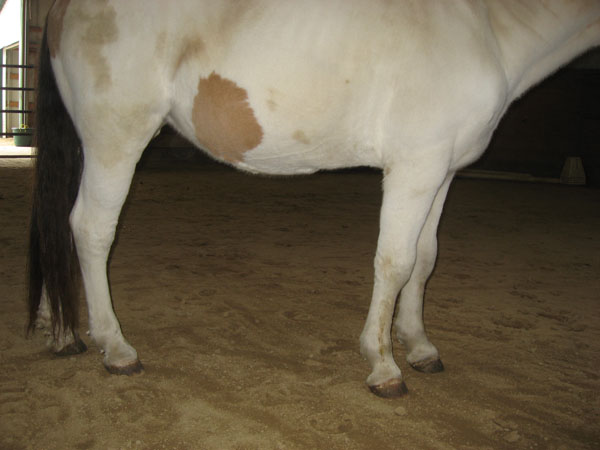 I'll let you know what the blood tests say. Jackie |
| Moderator: DrO |
Posted on Tuesday, Nov 6, 2007 - 7:15 am: I cannot figure out how a weakened immune system is an explanation for passive edema all the way around unless he thinks all 4 legs have become infected simultaneously.If you assume this is vaccine related a better explanation is just the opposite: the immune system has over reactied to the vaccine causing a mild vasculitis to the immune complexes circulating following vaccination and this has created a active edema secondary to a immune mediated vasculitis. This condition has a name: purpura. I say "mild" because the above swelling is not so bad and instead of being hot it is cool. If no worse than above keeping the horse out, NSAID's, and pressure wrapping if the horse must be up will be fine until it passes. I would not be sweating these legs as it may increase the inflammation, just pressure. If it worsens consider more aggressive antiinflammatory therapy. As to vaccine frequency this varies depending on which brand of vaccine, disease prevalence, and even your goals. For more on this and general recommendations see Vaccine Schedules. To check for particular vaccines see the articles on the particular disease. DrO |
| Member: bluedog1 |
Posted on Tuesday, Nov 13, 2007 - 9:16 am: Hi Dr. O,An update on Dakotah. The swelling has disappeared everywhere except her hocks which remain somewhat thick looking. The blood tests taken on Nov 5 were reported to me as: low albumin, anemia and elevated calcium. I am requesting a copy so I can have actual numbers. I have started her on daily dewormer and adding 1 lb of roasted soy beans to her daily ration. We will recheck her bloodwork in 2 months. Otherwise, she is sound, happy, and gaining back some weight. The other problem I constantly have to deal with is her incredible hair growth. We body clip her monthly in the warm months, but as soon as her hair gets a little long, she gets this black sooty looking stuff all over her back, butt, and lower legs. Shampoo alone does not get rid of it, but betadine scrub seems to do the trick for a while. I'm assuming it's some sort of fungal infection. I wish there was a way that I could let her have some hair for the winter without having this stuff grow all over the place. Any ideas or products you would recommend would be very helpful. Jackie |
| Moderator: DrO |
Posted on Tuesday, Nov 13, 2007 - 1:07 pm: Unless she has irritated skin or is loosing hair fungus is unlikely. Assuming she does not stand below trees or machinery that secrete something on her, more likely you are seeing increased sweat and oil (sebum) and dead cell (keratin) production. This is seen in some Cushings horses which along with the increased sweating give them oily-flaky-grimey look.DrO |
| Member: bluedog1 |
Posted on Wednesday, Nov 14, 2007 - 3:21 pm: Thanks Dr. O.This will be the last post on this thread. Dakotah seems to have recovered from the pain, weight loss and laminitic episode. The only persistant problem is the wet manure, some residual swelling in her hocks, and some abnormal values in the blood work. Hopefully everything will work out. We pressure wrap her legs at night if they look thick and she is being exercised 5 times per week. She went from being an easy keeper to a hard keeper, but the diet she is on now seems to be doing the trick. I know it can take a long time to regain weight lost, but all looks well so far. As for the blood values, we will check them again in 2 months. Thanks for your help and advice. I always look forward to what you have to say. Here is a picture of Dakotah from today and one taken 6 weeks ago. Hope you have a wonderful Thanksgiving! Jackie 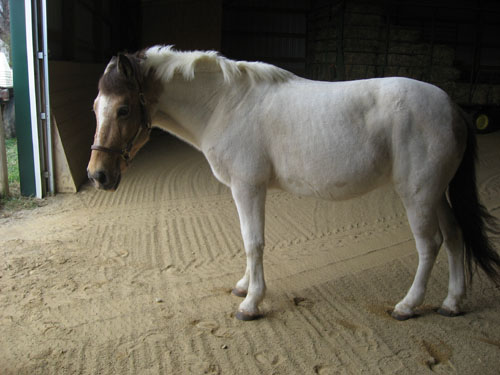 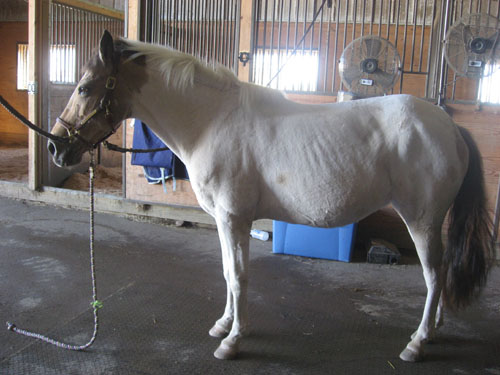
|
| Moderator: DrO |
Posted on Thursday, Nov 15, 2007 - 7:24 am: Delighted to hear things are straightening out Jackie and thanks for the kudos.DrO |
is The Horseman's Advisor
Helping Thousands of Equestrians, Farriers, and Veterinarians Every Day
All rights reserved, © 1997 -
